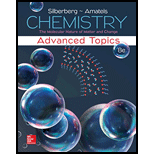
Concept explainers
(a)
Interpretation:
The balanced molecular, total ionic, and net ionic equations for the reaction that occurs when the solutions are mixed are to be determined.
Concept introduction:
There are three types of equations that are utilized to represent an ionic reaction:
1. Molecular equation
2. Total ionic equation
3. Net ionic equation
The molecular equation represents the reactants and products of the ionic reaction in undissociated form. In total ionic reaction, all the dissociated ions that are present in the reaction mixture are represented and in net ionic reaction, the useful ions that participate in the reaction are represented.
Precipitation reaction involves the reaction of two soluble ionic compounds to form an insoluble product. The insoluble product is known as a precipitate.
(a)
Answer to Problem 4.150P
The balanced molecular equation of the reaction is as follows:
The total ionic equation for the given reaction is as follows:
The net ionic equation for the given reaction is as follows:
Explanation of Solution
The first beaker consists of sodium carbonate
The total ionic equation for the given reaction is as follows:
The net ionic equation for the given reaction is as follows:
(b)
Interpretation:
Mass of precipitate formed when the yield is
Concept introduction:
Precipitation reaction involves the reaction of two soluble ionic compounds to form an insoluble product. The insoluble product is known as a precipitate.
The reason for the precipitation reaction to occur is the formation of a product that is insoluble in nature. The insoluble product is formed when the electrostatic attraction between the ions is greater as compared to the attraction between ions and water molecule. The product will remain intact and precipitate out from the solution.
(b)
Answer to Problem 4.150P
Mass of precipitate formed when the yield is
Explanation of Solution
The formula to calculate the mass of
Substitute
Mass of precipitate formed when the yield is
(c)
Interpretation:
The concentration of each ion in solution after reaction is to be calculated.
Concept introduction:
Precipitation reaction involves the reaction of two soluble ionic compounds to form an insoluble product. The insoluble product is known as a precipitate.
The reason for the precipitation reaction to occur is the formation of a product that is insoluble in nature. The insoluble product is formed when the electrostatic attraction between the ions is greater as compared to the attraction between ions and water molecule. The product will remain intact and precipitate out from the solution.
(c)
Answer to Problem 4.150P
The concentration of
Explanation of Solution
The formula to calculate moles of
Substitute 6 spheres for number of
The formula to calculate moles of
Substitute 3 spheres for number of
The formula to calculate moles of
Substitute 2 spheres for number of
The formula to calculate moles of
Substitute 4 spheres for a number of
After the reaction, the moles of
The formula to calculate moles of
Substitute
The total volume of solution is the sum of the volume of both the beaker that is
The formula to calculate the molarity of
Substitute
The formula to calculate the molarity of
Substitute
The formula to calculate molarity of
Substitute
The concentration of
Want to see more full solutions like this?
Chapter 4 Solutions
Student Solutions Manual For Silberberg Chemistry: The Molecular Nature Of Matter And Change With Advanced Topics
- For CARS, which statement is not true regarding its advantages? a) Contrast signal based on vibrational characteristics, no need for fluorescent tagging. b) Stronger signals than spontaneous Raman. c) Suffers from fluorescence interference, because CARS signal is at high frequency. d) Faster, more efficient imaging for real-time analysis. e) Higher resolution than spontaneous Raman microscopy.arrow_forwardDraw the major product of the Claisen condensation reaction between two molecules of this ester. Ignore inorganic byproducts. Incorrect, 5 attempts remaining 1. NaOCH3/CH3OH 2. Acidic workup Select to Draw O Incorrect, 5 attempts remaining The total number of carbons in the parent chain is incorrect. Review the reaction conditions including starting materials and/or intermediate structures and recount the number of carbon atoms in the parent chain of your structure. OKarrow_forwardUsing a cell of known pathlength b = 1.25115 x 10-3 cm, a water absorption spectrum was measured. The band at 1645 cm-1, assigned to the O-H bending, showed an absorbance, A, of 1.40. a) Assuming that water density is 1.00 g/mL, calculate the water molar concentration c (hint: M= mole/L) b) Calculate the molar absorptivity, a, of the 1645 cm-1 band c) The transmitted light, I, can be written as I= Ioexp(-xb), where x is the absorption coefficient (sometimes designated as alpha), Io is the input light, and b is the cell pathlength. Prove that x= (ln10)*x*c d) Calculate x for the 1645 cm-1 bandarrow_forward
- Convert 1.38 eV into wavelength (nm) and wavenumber (cm-1) (c = 2.998 x 108 m/s; h = 6.626 x 10-34 J*s).arrow_forwardCan you help me understand the CBC method on metal bridging by looking at this problem?arrow_forwardA partir de Aluminio y Co(NO3)2ꞏ6H2O, indicar las reacciones a realizar para obtener Azul de Thenard (Al2CoO4).arrow_forward
 ChemistryChemistryISBN:9781305957404Author:Steven S. Zumdahl, Susan A. Zumdahl, Donald J. DeCostePublisher:Cengage Learning
ChemistryChemistryISBN:9781305957404Author:Steven S. Zumdahl, Susan A. Zumdahl, Donald J. DeCostePublisher:Cengage Learning ChemistryChemistryISBN:9781259911156Author:Raymond Chang Dr., Jason Overby ProfessorPublisher:McGraw-Hill Education
ChemistryChemistryISBN:9781259911156Author:Raymond Chang Dr., Jason Overby ProfessorPublisher:McGraw-Hill Education Principles of Instrumental AnalysisChemistryISBN:9781305577213Author:Douglas A. Skoog, F. James Holler, Stanley R. CrouchPublisher:Cengage Learning
Principles of Instrumental AnalysisChemistryISBN:9781305577213Author:Douglas A. Skoog, F. James Holler, Stanley R. CrouchPublisher:Cengage Learning Organic ChemistryChemistryISBN:9780078021558Author:Janice Gorzynski Smith Dr.Publisher:McGraw-Hill Education
Organic ChemistryChemistryISBN:9780078021558Author:Janice Gorzynski Smith Dr.Publisher:McGraw-Hill Education Chemistry: Principles and ReactionsChemistryISBN:9781305079373Author:William L. Masterton, Cecile N. HurleyPublisher:Cengage Learning
Chemistry: Principles and ReactionsChemistryISBN:9781305079373Author:William L. Masterton, Cecile N. HurleyPublisher:Cengage Learning Elementary Principles of Chemical Processes, Bind...ChemistryISBN:9781118431221Author:Richard M. Felder, Ronald W. Rousseau, Lisa G. BullardPublisher:WILEY
Elementary Principles of Chemical Processes, Bind...ChemistryISBN:9781118431221Author:Richard M. Felder, Ronald W. Rousseau, Lisa G. BullardPublisher:WILEY





